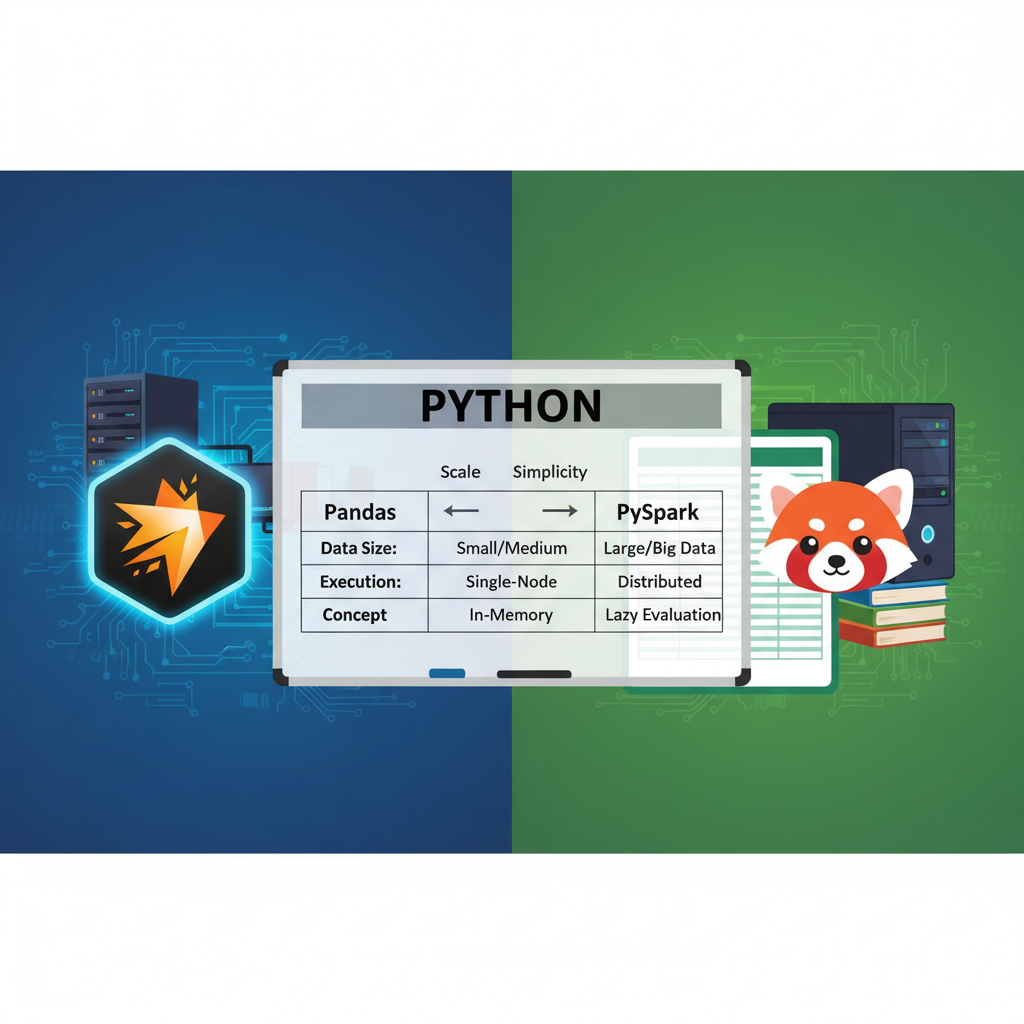PySpark vs Pandas: Choosing Right! 🐍

As another project wraps up, bringing with it the bittersweet relief of an almost-closed chapter (and, yes, a few too many late-night coding sessions), I found myself reflecting on the tools that got us through.
This last project— AD688—was, frankly, a bit of a messy in a good way. But within the chaos of wrangling data and generating reports, a few things became crystal clear. Chief among them: the sheer power and contrasting philosophies of Pandas and PySpark, all running beautifully on top of Python.
We used PySpark consistently throughout our assignments, and I was genuinely blown away by how much practical knowledge is out there to help tame its complexities. But the experience highlighted a critical choice every data professional faces: When do you stay local and lean on Pandas, and when do you go distributed with PySpark?
The answer, as always, is it depends on the data.
I’ve distilled my learnings into a simplified view that highlights the fundamental differences between these two Python titans. It’s the information I wish I had on day one!
A Brief History: Why These Tools Exist
The difference between these libraries is rooted in their origin stories:
- Pandas (Born 2008): Created by Wes McKinney at AQR Capital Management to handle high-performance quantitative analysis on financial data in Python. The name is derived from “Panel Data.” It was built for single-machine, in-memory operations, offering the flexibility and power of data structures found in languages like R.
Example
import pandas as pd
import numpy as np
# 1. Configuration (None needed, it's just Python)
# 2. Create/Load DataFrame (Eager Execution)
data = {'Name': ['Alice', 'Bob', 'Charlie'], 'Salary': [70000, 80000, 90000]}
df = pd.DataFrame(data)
# 3. Perform an Action (Immediate)
print("Pandas Head:")
print(df.head(1))- Apache Spark (Born 2009, PySpark API added later): Developed by Matei Zaharia at UC Berkeley’s AMPLab to overcome the limitations of Hadoop’s MapReduce framework, specifically its poor performance for iterative algorithms (like those in Machine Learning) and interactive analysis. Spark’s focus from day one was in-memory, fault-tolerant, distributed computing at a massive scale. PySpark is simply the Python interface to this powerful engine.
Example
from pyspark.sql import SparkSession
# 1. Configuration: Create a SparkSession
# 'local[*]' means use all available cores on the local machine
spark = SparkSession.builder \
.appName("Samarthya") \
.config("spark.executor.memory", "4g") \
.getOrCreate()
# 2. Create/Load DataFrame (Lazy Execution)
# The DataFrame is created but the operations are not fully executed yet
data = [("Alice", 70000), ("Bob", 80000), ("Charlie", 90000)]
columns = ["Name", "Salary"]
spark_df = spark.createDataFrame(data, columns)
# 3. Perform an Action (Triggers Execution)
print("Information:")
spark_df.limit(1).show()
# Clean up the session when done
spark.stop()The Core Difference: Single Machine vs. Distributed Cluster
The key to understanding Pandas and PySpark isn’t just their function (they both manipulate dataframes); it’s their architecture.
Pandas is the ultimate in-memory, single-machine hero. It’s fast, intuitive, and the gold standard for exploratory data analysis.
PySpark (the Python API for Apache Spark) is the big-data champion. It scales horizontally, distributing massive tasks and datasets across a cluster of machines.
Here is a quick-reference guide to help you choose your weapon:
| Feature | Pandas | PySpark |
| Data Size | Small to medium (fits in a single machine’s RAM) | Large-scale/Big Data (Terabytes to Petabytes) |
| Execution | Single-core/Single-machine in-memory processing | Distributed across a cluster of machines/cores |
| Evaluation | Eager (operations run immediately) | Lazy (operations are optimized and executed only when an action is called) |
| Fault Tolerance | Limited (if the process fails, data may be lost) | Built-in (data is distributed and can be recovered if a node fails) |
| Data Structure | DataFrame and Series (in-memory) | DataFrame (distributed collection of data) and RDDs (lower-level) |
| Learning Curve | Lower, intuitive for Python users | Steeper, requires understanding of distributed concepts |
Choosing Your Tool: A Simple Rule of Thumb
- If your data fits comfortably on your laptop’s RAM? Go with Pandas. The overhead of initializing a Spark cluster isn’t worth it. You get simple, immediate, and high-performance operations.
- If your data is too big for a single machine’s memory, or you need to process it across multiple nodes? You need the scalability and fault tolerance of PySpark. It’s the only way to tackle “Big Data.”
If you need to look at how my code evolved for the project – have a look here.
